Join Amazon Prime - Watch Thousands of Movies & TV Shows Anytime - Start Free Trial Now

Register a SNAP EBT card with Amazon
The Republic P-44
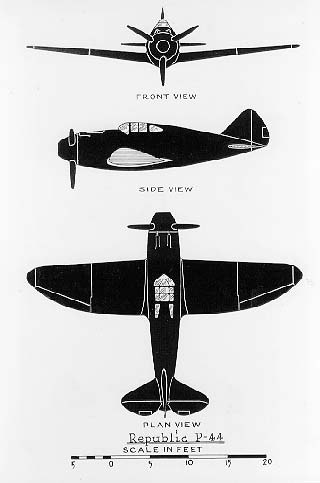 Although never placed into production, the P-44 was the evolutionary link between the Lancer and the Thunderbolt
On a crisp early May morning in 1941, as a newly completed Republic AT-12, sat
waiting for delivery. Another, larger aircraft was rolled out and pushed alongside.
The larger aircraft looked familiar, not unlike the P-43’s which were being built that
very day. Yet, this plane was far more massive with an engine cowling which was oval
instead of round. The huge propeller had 4 blades, unlike the P-43’s three blades.
As the morning sun reflected off the polished Alclad skin, the passersby on the
adjacent road would not remember having witnessed the birth of the fighter that
would determine who owned the sky over France and Germany 3 years later.
Although never placed into production, the P-44 was the evolutionary link between the Lancer and the Thunderbolt
On a crisp early May morning in 1941, as a newly completed Republic AT-12, sat
waiting for delivery. Another, larger aircraft was rolled out and pushed alongside.
The larger aircraft looked familiar, not unlike the P-43’s which were being built that
very day. Yet, this plane was far more massive with an engine cowling which was oval
instead of round. The huge propeller had 4 blades, unlike the P-43’s three blades.
As the morning sun reflected off the polished Alclad skin, the passersby on the
adjacent road would not remember having witnessed the birth of the fighter that
would determine who owned the sky over France and Germany 3 years later.
The XP-47B would soon demonstrate its brute power and rugged construction
by evolving into one of the war’s most important fighters. Named the Thunderbolt,
a name which would foreshadow its reputation, it was the first truly successful
aircraft to be manufactured by Republic Aviation. Republic having evolved from
Seversky Aircraft Corporation, reorganized after the ouster of Alexander Seversky.
More so than any other American WWII fighter plane, the P-47 was the result of
an evolutionary process that began as early as 1935. It is very easy to see the
basic lines of the Thunderbolt’s elliptical shaped wing in the SEV-1XP, from
which, was developed the P-35. The SEV-1XP had won the fighter competition
and was awarded a contract in 1936. The P-35 was the result. With good range
and excellent handling, the P-35 was well liked when it first deployed to the 1st
Pursuit Group. Nonetheless, there were some glaring faults in the aircraft. The
design of the landing gear was poor, in that the wheels simply folded back into
fairings, instead of folding flush as on the Curtiss P-36. The design of the short
coupled gear made the P-35 an easy aircraft to ground loop. From the outset,
the P-35 suffered from problems with its propeller, which were only exacerbated
as time accumulated on the engine. However, viewed alongside its contemporaries,
the P-35 was a solid design for it’s era.
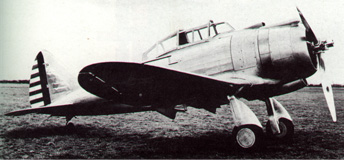 Seversky P-35
Seversky P-35
After being reorganized as Republic Aviation, an order was taken from Sweden
for the EP1-106, essentially a development of the P-35 with 20 inches added
to the length of the fuselage. There were other minor changes, not easily spotted.
Interesting enough, the Italian’s thought highly enough of the P-35/EP1-106 to
blatantly copy it as the Reggiane Re.2000. The Italians improved the landing gear,
designing a flush folding system. A reworked greenhouse and a different engine
installation do little to hide the aircraft’s ancestry. The Swedes were very happy with
the EP1-106, keeping them in service until 1947. They marveled at the little fighter’s
manueverability, noting that it gave their older Gloster Gladiator biplanes fits. As of
this writing, only two are known to have survived. One EP1-106 currently resides in the
Swedish Air force Museum. The second was presented to the USAF museum at Dayton Ohio.
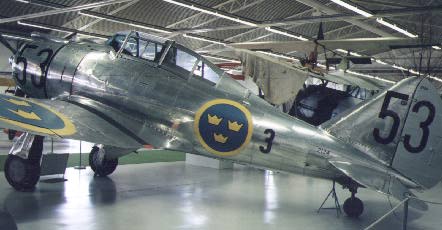 EP1-106 in the Swedish Air Force Museum
Image courtesy of Urban Fredriksson's Swedish Military Aviation Page.
EP1-106 in the Swedish Air Force Museum
Image courtesy of Urban Fredriksson's Swedish Military Aviation Page.
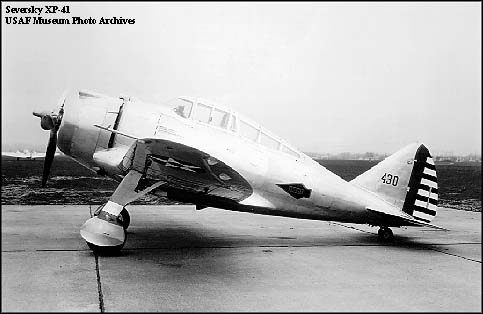 Seversky XP-41
Seversky XP-41
Development at Seversky/Republic continued despite very tight finances. For the
1939 Pursuit Competition, two new designs appeared in the name of the XP-41 and AP-4.
Even though these aircraft looked very much alike, there were significant
differences between them. Being the brainchild of Alex Seversky, the AP-4 employed
a different design of the main landing gear than Kartveli’s XP-41, both, however,
being flush folding. Both aircraft shared tooling and components. Yet, Seversky’s design
was very different than the XP-41 internally. The most important difference was that
"Shasha" Kartveli selected a supercharged P&W R-1830 powerplant, Seversky installed
a turbo-supercharger in the aft fuselage. This installation was a foretaste of
things to come. The XP-41 did not offer any improvement in performance over the
AP-2 of 1937 and was shipped to Langley Field for wind tunnel testing, never to be
heard of again. The AP-4, on the other hand, arrived too late for the competition. The
Curtiss XP-40, which did not win the competition, was selected and a contract for 524
P-40 fighters was issued.
Yet, not everyone involved was near sighted or politically motivated. The only
aircraft displaying good high altitude performance above 20,000 feet was the AP-4.
Even though the prototype was destroyed by a fire and crash (a crack in the exhaust
plumbing set fire to the fuselage in flight), it’s performance was good enough that a
contract was issued for 13 additional aircraft, designated the YP-43.
The first YP-43 was ready for flight testing in March of 1940. Its appearance was
somewhat different from the prototype having lost the oversized spinner and the
cockpit glass was revised to resemble what would eventually appear on the P-47B.
Other than these changes, the aircraft was essentially the AP-4. The turbocharged
R-1830-35 engine mated to the B-2 type turbo produced 351mph at over 20,000
feet. Clearly, this was better than the P-40B, but it was no better than the Supermarine
Spitfire Mk I or the Messerschmitt Bf-109E. At least, in the P-43, the Air Corps was
in the ballgame.
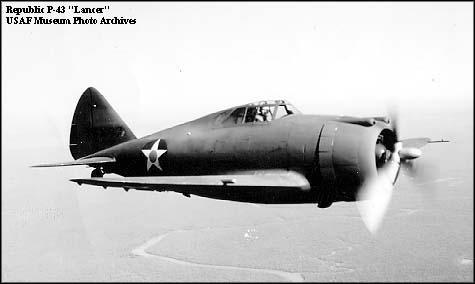 Republic P-43 Lancer
Republic P-43 Lancer
Shortly after receiving the contract for the YP-43, Republic presented the Air Corps
with it’s proposal for the P-44 to meet the requirements of AAC Circular Proposal
39-770. Originally designated internally as the AP-4B, the design was to incorporate
the R-2180 engine and the early design sketches reflect this engine (see the 3 view
drawing at the top of this page). When that engine failed to live up to its promise,
Republic selected the Wright R-2600. Unfortunately, as Grumman was to later
discover, the R-2600 did not respond well to turbocharging. Luckily for Republic,
before actual engineering drawings were laid down, the newly developed Pratt & Whitney
R-2800 engine became available. This new engine, powering Vought’s
XF4U-1 to over 400 mph, was quickly selected for the AP-4C or P-44-IV. Republic
received a preliminary order for 80 of the aircraft based solely upon "Shasha"
Kartveli's written proposal.
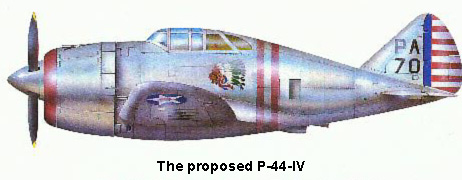 Bob Boyd/Warren Bodie image
Bob Boyd/Warren Bodie image
The engineering staff at Republic went to work on a mock-up of their new proposal.
The P-43 Lancer was selected to be the basis of the new design. The new engine
required a major modification to the cowling and as a result, the fuselage. The new
cowling was oval in shape to accommodate the oil cooler being installed below the
engine. To properly blend the cowling, the fuselage was deepened as well. A new
4 blade Curtiss Electric prop was fitted. Even as the mock-up approached completion,
the requirements of the USAAC were undergoing a radical change.
The Air Corps was becoming unsure about placing all their marbles into that bag
called the Allison V-1710 liquid cooled V12 engine. If the Allison did not live up
to expectations, what were the alternatives? The time required to redesign an
existing fighter to use one of the newer radial engines would be excessive. More
so in the event of war. An investigation of the AAC pursuit plane program was set
in motion, called the Emmons Board, it strongly recommended that alternatives to
the Allison powered fighters be developed using air cooled radial powerplants.
Moreover, they pushed for the design and/or development of different liquid cooled
engines as well. That General "Hap" Arnold signed off on the report, was very
important. Arnold, being the Chief of the Air Corps, sent a strong message by
endorsing the recommendations, despite his being a leading advocate of the Allison.
The Experimental Aircraft Division, in anticipation of the Emmons Board report,
sent for the senior officials of Republic Aviation. Having drawn up a new set of
requirements, the EAD surprised Kartveli and co. by informing them that any new
design must attain at least 400 mph at 25,000 feet. It must be armed with a minimum
of six .50 cal. Machine guns, 8 were preferred, and they must be mounted in the wings.
Armor and self sealing fuel tanks were expected as well.
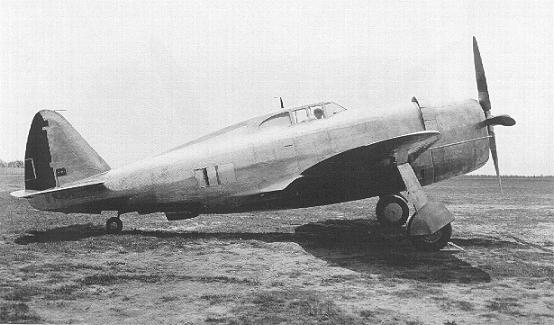 Republic XP-47B Thunderbolt
Republic Aviation archive photo
Republic XP-47B Thunderbolt
Republic Aviation archive photo
Instantly, Kartveli understood that the P-44 could not hope to be modified to meet
these new parameters. The wing could not accommodate the armament. The basic
P-43 airframe used for the P-44 mock-up was not readily adaptable to the changes
necessary to meet the specifications now in place. When Kartveli departed to return
to Long Island, he carried several written agreements. The development of the P-44
would cease immediately. All development work on the Allison powered XP-47 and
XP-47A would cease immediately. Republic was to begin work on designing a new
fighter to be designated the XP-47B. It would be powered by the P&W R-2800-11
radial rated at 2,000 bhp @ 25,000 feet. Kartveli decided that the basic wing shape
was more than adequate. The cockpit was good enough as well. A better G.E.
turbocharger was now available, which promised even better performance than the
B-2. Before Kartveli's train had arrived in New York City, the basic design was already
sketched on paper. Compared to the P-44, the new aircraft would be far larger and
heavier. Yet, the general appearance would be a distinct reminder of it’s ancestry.
Eight months after receiving the contract, on a crisp May morning, the first Thunderbolt
was rolled out in preparation for its initial test flight. Little did anyone realize the
impact this new fighter would have on the air war.
The P-44 mock-up was disassembled, to be largely forgotten as the precursor of
the fighter that ultimately broke the back of the Luftwaffe in western Europe.
Special thanks to Hakan Gustavsson for up
to date information on the EP1-106
and to Urban Fredriksson for the color
image of the aircraft.
RESOURCES:
Warren M. Bodie, Republic's P-47 Thunderbolt: From Seversky to Victory .
.
Roger Freeman, The Republic P-47N Thunderbolt .
.
Enzo Angelucci and Peter Bowers, American Fighter .
.

Unless otherwise indicated, all articles Copyright © Corey C. Jordan 1998.
Reproduction for distribution, or posting to a public forum without express
written permission is a violation of applicable copyright law. Some backgrounds
images
used on this website are the artwork of Corey C. Jordan. Reproduction for distribution,
or
posting these background images to a public forum without written permission is prohibited.









